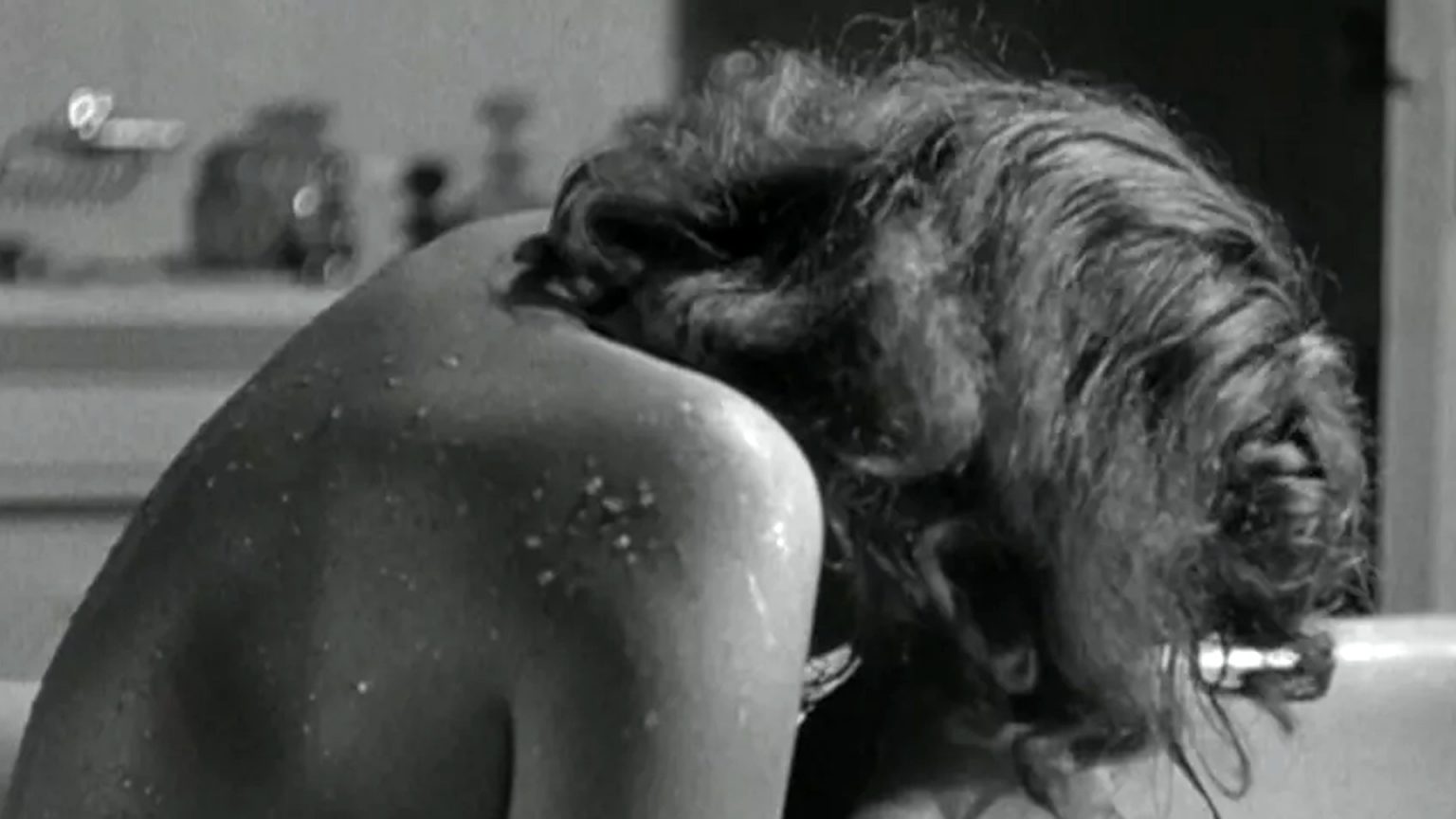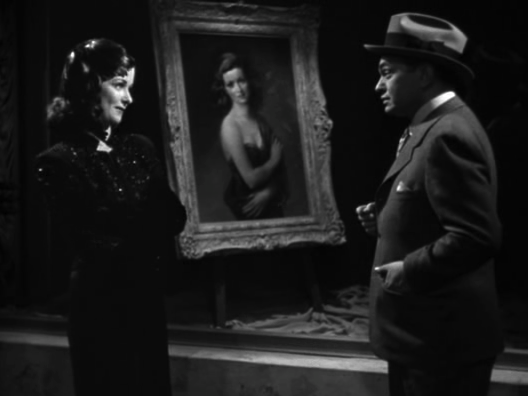A few years ago, I took a friend to see Fritz Lang’s The Woman in the Window (1944) as part of a film noir double bill at the Stanford Theatre in Palo Alto. Neither of us had seen the film, nor did we know anything about it beyond a vague awareness of its prominence in the Hollywood noir canon. But one should never turn down a movie at the Stanford; a restored Art Deco movie palace, it reliably draws a large, receptive Saturday night crowd. It’s hard to imagine a more ideal setting to take in the sordid tale of Richard Wanley (Edward G. Robinson), professor of psychology.
Wanley is something of a homebody—“cooped up,” as his wife puts it—leading a life so comfortably banal it’s easy to imagine that nothing interesting has ever happened to him. When his wife and son head out of town, he gets the freedom of temporary bachelor status, which he uses to go to a bourgeois gentleman’s club, sit in a plush armchair, and have a drink with old friends. Reminiscing into the night, they discuss their admiration for a beautiful mystery woman (Joan Bennett) whose portrait is displayed in a window outside. Sometime later in the evening, Wanley emerges from the club alone and runs into the woman herself, sexy and available. She invites him home. Naturally, he goes and quickly drops into an anxious, twisty 1940s rabbit hole that includes such stock noir elements as murder, blackmail, guilt, suspicion, sexual menace, and character actor Dan Duryea. By the finale, Wanley decides to end it all. He swallows an overdose, but just as he expires, he’s suddenly shaken awake—back in the armchair at the gentleman’s club. The murder, the blackmail: None of it happened. It was all just a dream.
I’ve never seen a more seditious audience. An eruption of groans and jeers rippled across the theater. One gentleman shouted, “What!?! What!?!” over and over. On the way out, any noir mood had been completely deflated, and from the chatter in the lobby, one might judge that what we had just seen was something cemented in hopeless naivety. Surely we, as a modern audience, know better by now? To put it mildly, “it was all a dream” is a trope that doesn’t command much respect these days. In its most benign form, it’s an old-fashioned way of segueing from a real-world to a fantastical one, a la The Wizard of Oz (1939). At its worst, it’s a cheap cop-out, a contrived way of pulling the rug out from under the audience and leaving them with nothing. After all, hasn’t the audience paid to see something actually happen?
The Woman in the Window
It depends on what you mean by “happen.” An avant-gardist, or at least a contrarian, could argue that nothing in a movie actually happens, other than a stream of images projected on a wall to captive spectators. Surrealists and early film theorists were quick to spot the link between this essential mechanism of cinema and the experience of dreams, and the way this new technology could compress time, space, and logic like no medium before it. One of the earliest feature films to so deftly play with the idea of malleable reality, to fuse an avant-garde sensibility to commercial narrative form, was Robert Wiene’s classic of German Expressionist horror, The Cabinet of Dr. Caligari (1920), where once again we find the involvement of Fritz Lang. Lang was briefly involved with Caligari during pre-production, and he left the film with a key contribution: a framing device, revealing that the hero is a madman, and the horror story was in his mind. The screenwriters protested, fearing this would effectively neutralize the narrative in the middle. But the ending of Caligari that wound up on screen is deeply creepy to this day, and that framing device is one of its most vital contributions to cinema: a pitch-perfect case study of a film as an explicitly subjective world, visualizing an inner life, reflecting a reality we can sense but never directly see.
So what is the inner life of Professor Richard Wanley? It’s a question that The Woman in the Window clearly wants us to ask; the film opens with Wanley giving a lecture on “impulses behind homicide,” the name “Sigmund Freud” written in large letters on the blackboard behind him. (Freud’s philosophy looms like a dubious Caligari over so many classical Hollywood films.) Knowing Wanley’s misadventure is all in his head puts his behavior during the dream in a peculiar light: It is Wanley who commits the first murder, suggests covering it up, and masterminds a second—and, in an uncanny way, he seems strikingly unperturbed by it. Do these “impulses” exist somewhere in the back of his brain? Does he want them? Do they frighten him? Either way, he’ll scuttle back to the security of his home, never consciously seeking out the more frightful side of the story he watched. He’s like the audience of a movie.
Here’s the true potential of the “it was all a dream” trope: the exploration of private reality. Although undeniably there are far more empty dream endings than good ones, cinema is nonetheless dotted with films that draw an explicit or ambiguous line between dreams and reality and get their effect by placing the primary action in the former instead of the latter. Caligari and Window are two classic examples. But you can also see it in Powell and Pressburger’s A Matter of Life and Death (1946), as a study of optimism surviving trauma; in Paul Verhoeven‘s Total Recall (1990), as a sly satire of the wish-fulfillment fantasies of Schwarzenegger action flicks; in Hong Sang-soo’s Nobody’s Daughter Haewon (2013), as an angle on one heroine’s tangled relationships with men; and David Lynch‘s Mulholland Drive (2001), as an illusory vision of self that breaks into shards upon waking. Each of these films is laced with details that make them more intriguing, not less if they’re seen to unfold in a character’s mind—to not be real even within their own universes.
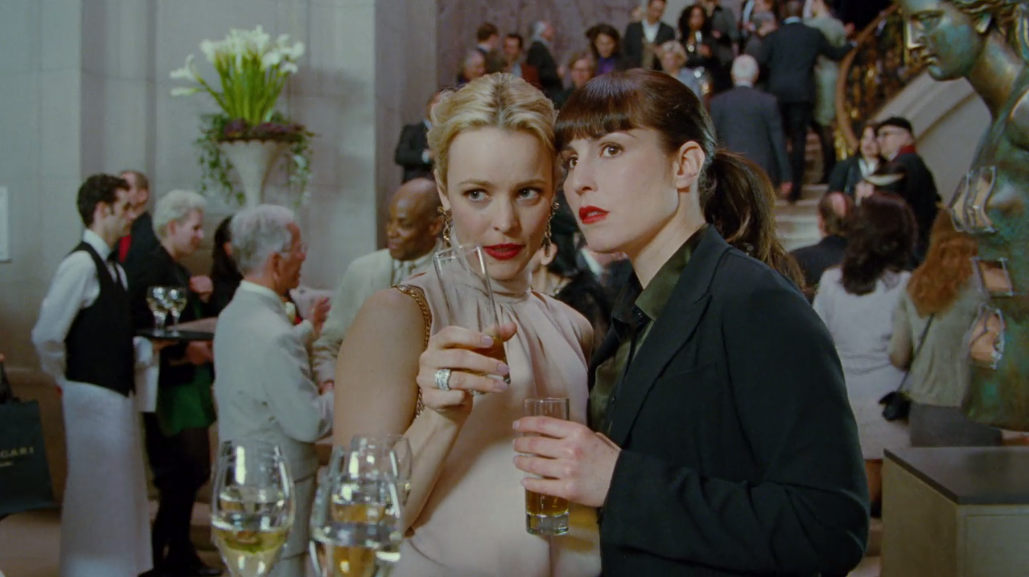
After largely falling off Hollywood’s radar, De Palma had a moment in the spotlight this summer thanks to Noah Baumbach and Jake Paltrow’s new documentary about him, as well as comprehensive retrospectives in New York, Toronto, and hopefully more to come. Of the so-called “Movie Brats” who stormed Hollywood in the 1970s—including Scorsese, Spielberg, and Coppola—De Palma is the one who remains most devoted to oneiric cinema, to movies as dreams. In some cases, this is literal: His horror classics Carrie (1976) and Dressed to Kill (1980) both move into dream states for their final scares, while Femme Fatale (2002) takes the dream trope to such a boldly preposterous extreme that one has to laugh, admire, and psychoanalyze it all at once. But just as importantly, De Palma’s filmmaking style itself tends to operate on pure hypnotic highs: There are scenes in Obsession (1976), Body Double (1984), and Raising Cain (1992)—real scenes, scenes that happened—that are staged with such heightened expressionism that it wouldn’t be surprising at all if the protagonists suddenly sat up in bed. One of the joys of De Palma’s work is this formalist and dramatic excess, orchestrating set pieces and scenarios that force an emotional logic while throwing nearly every other kind out the window.
In this context, his latest film, Passion (2012), starring Rachel McAdams and Noomi Rapace, deserves a second look—or, for many cinephiles, a first. After its premiere at the Venice Film Festival, Passion was given the barest theatrical presence (widest release: fourteen theaters) alongside distribution on iTunes, which may be the model of the future, but for an English-language “genre film” hasn’t yet shaken off a certain direct-to-video stigma. Having recently closed out TIFF Cinematheque’s Brian De Palma retrospective, the film currently lives on Netflix, buried with the little context in a carousel of genres. (Steamy & Suspenseful Psychological Thrillers?) Passion’s muted reception was a sorry fate for a director once held shoulder-to-shoulder with Spielberg and Scorsese, and whose more divisive films of the 2000s, such as Mission to Mars (2000) and Redacted (2007), at least started arguments. Passion was treated as minor De Palma, and fair enough for a thriller built from an array of elements—doppelgangers, split-screen murders, music by Pino Donaggio, voyeuristic sexuality—that De Palma had used, more memorably, decades earlier. Still, it has something that so many mainstream American movies today are lacking: an appreciation for cinema’s irrational power over its audience. And De Palma, old-school enough that he closes Passion with a title card reading “The End,” made a film that’s best understood through the psychodramatic lens of classic noir, while at the same time working a twist on his own formula.
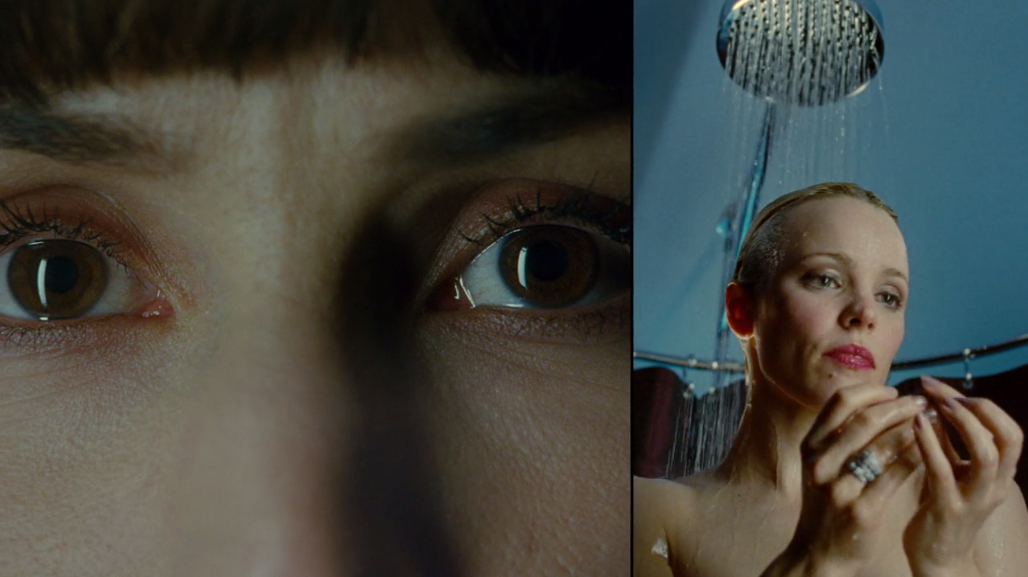
In discussing Passion as a dream narrative, one must be careful, because that’s a game that can keep the audience guessing. The heroine goes to bed at the beginning of the film and subsequently is shown falling asleep and suddenly waking up nearly half a dozen times. De Palma adapted his script from a French thriller called Love Crime (Alain Corneau, 2010), from which Passion gets its Euro-chic setting, the framework of its murder plot, and a battle of feminine cunning that should appeal to anyone who feels the word “bitch” may be used admiringly. But Love Crime plays the material relatively straight, with a very different ending. The feverish dream angle belongs to De Palma’s version alone.
So the best place to start is the one sequence I can say with confidence is “real,” the opening scene. Isabelle (Rapace) and Christine (McAdams), two coworkers at an ad agency, are meeting at Christine’s apartment after hours to discuss the latest campaign. As they share a drink and a few laughs, it’s instantly clear which of the two is dominant. Christine has perfect confidence, perfect style, perfect taste, a perfect apartment. Isabelle is much timider and repressed. Buttoned up in an asexual black pantsuit (which she’ll wear for most of the film, despite Christine’s many colorful costume changes), Isabelle is clearly in the thrall of her mentor and thrilled that such an alpha female would keep her as a confidante. She admires Christine—is it just professional, or something else? Then Christine’s perfect boyfriend arrives, and Isabelle, sensing that she’s become a third wheel, excuses herself and goes home. We see Isabelle drifting off to sleep, and then the story begins in proper: a tale of intrigue and murder as convoluted as any of Alfred Hitchcock‘s—and much clammier than Richard Wanley’s.
As a thriller, Passion has too many implausible twists to name. But as a glimpse into Isabelle’s psyche, it’s a hypnotic clash of identities. Isabelle competes with Christine. She sleeps with Christine’s boyfriend. Christine suddenly kisses Isabelle—a moment they scarcely dwell on—then teaches her to undo her top buttons to hook a male client. (“You’re more like me than you think,” Christine teases her.) And throughout this, the film’s style tilts towards insanity. Rapace plays Isabelle as a perpetually stunning figure, acting for most of the film like a helpless spectator, even to her own actions. The script is often daftly illogical; in one scene, Christine goes from threatening Isabelle to inviting her to a dinner party within a few seconds. Midway through, the film suddenly shifts into full-blown noir expressionism, with wall-to-wall canted angles and Venetian-blind shadows. The plot mechanisms by which someone may or may not get away with murder are as complex as they are irrelevant. Passion is more a series of anxious fantasies: to be Christine, to fuck Christine, to kill Christine. Though of course, in a nightmare, can you count on someone to stay dead?
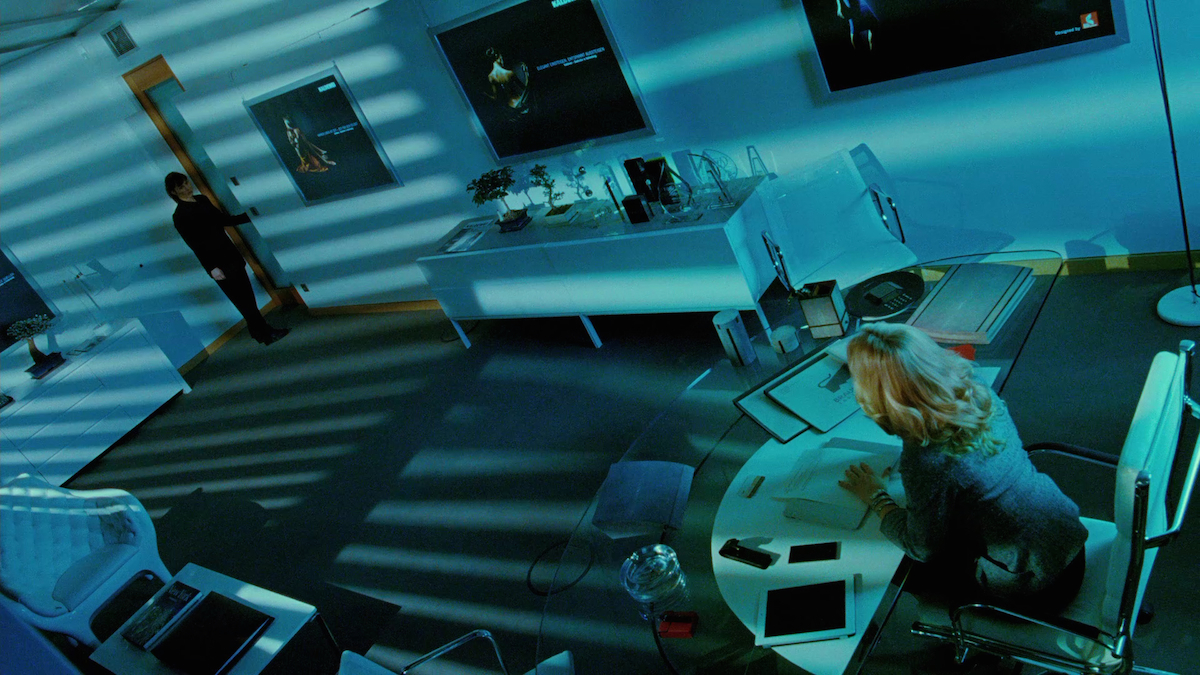
The crowning moment, where Passion adds something valuable to De Palma’s canon, is the final set-piece. This scene is De Palma in overheated form, the sort of ludicrous sequence that gets excruciating suspense from being so drawn out, and it involves a murder taking place in Isabelle’s apartment late at night, just as a police inspector drops by to “pay his respects.” There are numerous things that are logical “off” with this scene, not the least of which is why the inspector, who by this point in the contorted plot has been thoroughly fooled, would choose to pay a social visit in the middle of the night. But the sequence builds to a fever pitch, and then climaxes with the money shot: Isabelle convulsing awake, in the same bed she’d drifted off to sleep in after that opening scene—only now with a crucial, impossible detail.
De Palma is a self-aware filmmaker, not above referencing himself as well as his predecessors. The final shot of Passion, a high-angle view of the heroine waking up from a nightmare, is nearly identical to the shots that closed Carrie and Dressed to Kill. But here, De Palma adds one of his most mischievous touches: When Isabelle wakes up, the murder victim is still there, lying on the floor next to the bed, perfectly preserved from the prior sequence. As a finale, it’s a bonkers paradox: the construction of the editing means that this final sequence (if not the entire plot of the film) simultaneously must be a dream and can’t be a dream. There is no logical explanation, nor can there be, nor should there be.
This kind of gamesmanship may turn some audiences off as if the chain has been yanked a little too hard. But for such a modest, apparently trashy film, it’s also a sophisticated touch, and it relies on an audience willing to be subservient to the pure sounds and images that envelope them. It goes back to Richard Wanley’s epilogue, regaining his bearing after his feature-length nightmare; or to the hero of Caligari, confronting his horror back in real life, or to anyone who’s seen a scary movie late at night and finds it difficult to shake the unease. What De Palma’s Passion toys with, in a modern, old-fashioned way, is an idea both dreamlike and quintessentially cinematic: the fear (or hope) that what you’ve seen will be waiting for you on the other side.

